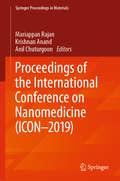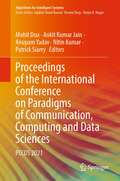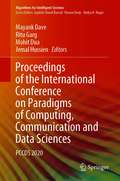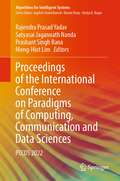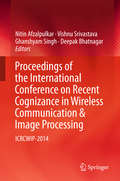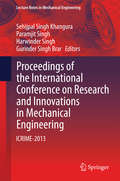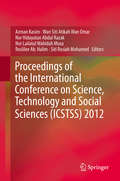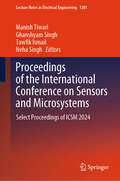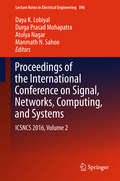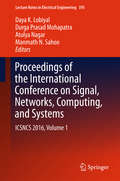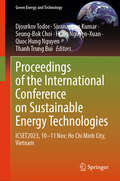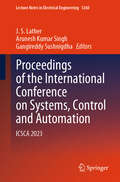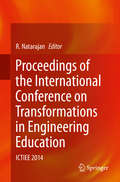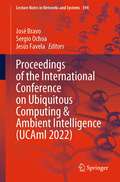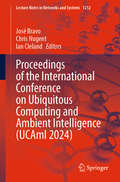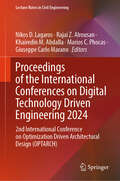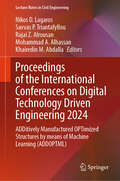- Table View
- List View
Proceedings of the International Conference on Nanomedicine (Springer Proceedings in Materials)
by Mariappan Rajan Krishnan Anand Anil ChuturgoonThis book presents the Proceedings of ICON–2019, an international meeting exclusively dedicated to nanostructured materials in medicinal applications. The conference emphasized the recent advances in multidisciplinary research on processing, morphol¬ogy, structure and properties of nanostructured materials and their applications in vari¬ous medicinal fields. The papers encompass basic studies and applications and address topics of novel issues, difficulties, and breakthroughs in the field of nanomedicine in cancer, tuberculosis, tissue engineering, regenerative medicine etc.
Proceedings of the International Conference on Paradigms of Communication, Computing and Data Sciences: PCCDS 2021 (Algorithms for Intelligent Systems)
by Patrick Siarry Anupam Yadav Mohit Dua Ankit Kumar Jain Nitin KumarThis book gathers selected high-quality research papers presented at the International Conference on Paradigms of Communication, Computing and Data Sciences (PCCDS 2021), held at the National Institute of Technology, Kurukshetra, India, during May 07–09, 2021. It discusses high-quality and cutting-edge research in the areas of advanced computing, communications, and data science techniques. The book is a collection of latest research articles in computation algorithm, communication, and data sciences, intertwined with each other for efficiency.
Proceedings of the International Conference on Paradigms of Computing, Communication and Data Sciences: PCCDS 2020 (Algorithms for Intelligent Systems)
by Mayank Dave Ritu Garg Mohit Dua Jemal HussienThis book presents best selected papers presented at the International Conference on Paradigms of Computing, Communication and Data Sciences (PCCDS 2020), organized by National Institute of Technology, Kurukshetra, India, during 1–3 May 2020. It discusses high-quality and cutting-edge research in the areas of advanced computing, communications and data science techniques. The book is a collection of latest research articles in computation algorithm, communication and data sciences, intertwined with each other for efficiency.
Proceedings of the International Conference on Paradigms of Computing, Communication and Data Sciences: PCCDS 2022 (Algorithms for Intelligent Systems)
by Meng-Hiot Lim Prashant Singh Rana Rajendra Prasad Yadav Satyasai Jagannath NandaThis book gathers selected high-quality research papers presented at International Conference on Paradigms of Communication, Computing and Data Sciences (PCCDS 2022), held at Malaviya National Institute of Technology Jaipur, India, during 05 – 07 July 2022. It discusses high-quality and cutting-edge research in the areas of advanced computing, communications and data science techniques. The book is a collection of latest research articles in computation algorithm, communication and data sciences, intertwined with each other for efficiency.
Proceedings of the International Conference on Radioscience, Equatorial Atmospheric Science and Environment and Humanosphere Science, 2021 (Springer Proceedings in Physics #275)
by Erma Yulihastin Prayitno Abadi Peberlin Sitompul Wendi HarjupaThis book presents recent advances in the area of Radioscience, Equatorial Atmospheric Science and Environment from the international symposium for equatorial atmosphere of the celebration of the Equatorial Atmosphere Radar (EAR) 20th Anniversary, conducted by Indonesian National Institute of Aeronautics and Space (LAPAN) and Kyoto University, in 2021. It provides a scientific platform for all participants to discuss ideas and current issues as well as to design solutions in the areas of atmospheric science, environmental science, space science, and related fields.
Proceedings of the International Conference on Radioscience, Equatorial Atmospheric Science and Environment and Humanosphere Science: INCREASE 2022, 22-23 Nov, Indonesia (Springer Proceedings in Physics #290)
by Erma Yulihastin Abdul Basit Sri Yudawati Cahyarini Heru Santoso Widodo S. Pranowo Lilik Slamet S. Halda Aditya BelgamanThis book highlights latest research advance in the field of Radioscience, Equatorial Atmospheric Science and Environment as part of the International Symposium for Equatorial Atmosphere celebrating the 21st Anniversary of the Equatorial Atmosphere Radar (EAR) , organized by Research Center for Climate and Atmosphere (PRIMA) of National Research and Innovation Agency (BRIN). The symposium provides a scientific platform for researchers and professionals to discuss ideas and current issues as well as to design the solutions in the areas of space science, ocean science, atmospheric science, , environmental science, material science, and other related disciplines.
Proceedings of the International Conference on Radioscience, Equatorial Atmospheric Science and Environment and Humanosphere Science: INCREASE 2023, 21–22 Nov, Indonesia (Springer Proceedings in Physics #305)
by Heru Santoso Sopia Lestari Marfasran Hendrizan Trismidianto Ginaldi Ari Nugroho Afif Budiyono Sri EkawatiThis book includes peer-reviewed articles from INCREASE 2023, Indonesia. It highlights research in the field of Radioscience, Equatorial Atmospheric Science and Environment organized by the Research Center for Climate and Atmosphere (PRIMA) of the National Research and Innovation Agency (BRIN). The symposium aims to provide a scientific platform for students, teachers, and researchers to discuss ideas and current issues in the areas of atmosphere and ocean observation, and prediction, climate change, urban climate, and sustainable development, atmospheric chemistry and air quality, atmosphere-ocean interaction and climate variability, atmosphere and space interaction, paleoclimatology, cloud physics and its application, and atmospheric dynamics and hydrometeorology.
Proceedings of the International Conference on Railway and Transportation (Advances in Engineering Research #220)
by Willy Artha Wirawan Moch. Agus Choiron Dian M. SetiawanThis is an open access book.Politeknik Perkeretaapian Indonesia Madiun, Indonesia, presents ICORT 2022 “Innovative for Smart, Sustainable and Safe Transportation Systems,” as its main focus. In response to several world challenges, such as sustainable development, transportation issues, global convergence of information and communications technologies, along with smart systems as opportunities as well as challenges in developments for better industries, it is considered important to discover innovative approaches from science and engineering perspectives. Innovation suggests the introduction of novelty to create better solutions. Innovation in engineering and science requires contributions from multidisciplinary sectors, academics, researchers, practitioners, and involving industries. All accepted papers from ICORT 2022 will be submitted in Proceeding or Jurnal Perkeretaapian Indonesia (Indonesian Railway Journal) (SINTA-indexed grade 4) or Journal of Railway Transportation and Technology (Indexed: Google Scholar, DOI, Dimensions, ROAD).Thus, ICORT 2022 invites academics or lecturers, researchers, practitioners, and involving industries in Science and Engineering fields to contribute their papers and works to be presented at our forthcoming conference.
Proceedings of the International Conference on Recent Cognizance in Wireless Communication & Image Processing
by Ghanshyam Singh Nitin Afzalpulkar Vishnu Srivastava Deepak BhatnagarThis volume comprises the proceedings of the International Conference on Recent Cognizance in Wireless Communication & Image Processing. It brings together content from academicians, researchers, and industry experts in areas of Wireless Communication and Image Processing. The volume provides a snapshot of current progress in computational creativity and a glimpse of future possibilities. The proceedings include two kinds of paper submissions: (i) regular papers addressing foundation issues, describing original research on creative systems development and modeling; and (ii) position papers describing work-in-progress or research directions for computational creativity. This work will be useful to professionals and researchers working in the core areas of wireless communications and image processing.
Proceedings of the International Conference on Research and Innovations in Mechanical Engineering
by Sehijpal Singh Khangura Paramjit Singh Harwinder Singh Gurinder Singh BrarThis book comprises the proceedings of International Conference on Research and Innovations in Mechanical Engineering (ICRIME 2013) organized by Guru Nanak Dev Engineering College, Ludhiana with support from AICTE, TEQIP, DST and PTU, Jalandhar. This international conference served as a premier forum for communication of new advances and research results in the fields of mechanical engineering. The proceedings reflect the conference's emphasis on strong methodological approaches and focus on applications within the domain of mechanical engineering. The contents of this volume aim to highlight new theoretical and experimental findings in the fields of mechanical engineering and closely related fields, including interdisciplinary fields such as robotics and mechatronics.
Proceedings of the International Conference on Science, Technology and Social Sciences (ICSTSS) 2012
by Siti Rosiah Mohamed Azman Kasim Wan Siti Atikah Wan Omar Nor Hidayatun Abdul Razak Nor Lailatul Wahidah Musa Roslilee Ab. HalimThis biannual conference in Pahang, Malaysia, is a clearing house for many of the latest research findings in a highly multidisciplinary field. The contributions span a host of academic disciplines which are themselves rapidly evolving, making this collection of 90 selected papers an invaluable snapshot of an arena of pure and applied science that produces many versatile innovations. The book covers a multitude of topics ranging from the sciences (pure and applied) to technology (computing and engineering), and on to social science disciplines such as business, education, and linguistics. The papers have been carefully chosen to represent the leading edge of the current research effort, and come from individuals and teams working right around the globe. They are a trusted point of reference for academicians and students intending to pursue higher-order research projects in relevant fields, and form a major contribution to the international exchange of ideas and strategies in the various technological and social science disciplines. It is the sheer scope of this volume that ensures its relevance in a scientific climate with a marked trend towards disciplinary synthesis.
Proceedings of the International Conference on Sensors and Microsystems: Select Proceedings of ICSM 2024 (Lecture Notes in Electrical Engineering #1381)
by Ghanshyam Singh Manish Tiwari Tawfik Ismail Neha SinghThis book constitutes peer-reviewed proceedings of the 1st International Conference on Sensors and Microsystems (ICSM-2024). This book discusses the latest technological advancements in designing and implementing sensors and microsystems. The book is a unique collection of chapters from different areas with a common theme. The book covers a broad range of topics relating to sensors and microsystems which includes physics, chemistry, and materials science of the sensors and sensor applications in biomedical, optoelectronic systems, control and verification, automated systems, human-computer interface, etc., with tailored intelligence to make a transformative impact on the economy, industry, and society. It is beneficial for academic researchers and practitioners in the industry who work in this field.
Proceedings of the International Conference on Signal, Networks, Computing, and Systems
by Durga Prasad Mohapatra Atulya Nagar Daya K. Lobiyal Manmath N. SahooThe book is a collection of high-quality peer-reviewed research papers presented in the first International Conference on Signal, Networks, Computing, and Systems (ICSNCS 2016) held at Jawaharlal Nehru University, New Delhi, India during February 25-27, 2016. The book is organized in to two volumes and primarily focuses on theory and applications in the broad areas of communication technology, computer science and information security. The book aims to bring together the latest scientific research works of academic scientists, professors, research scholars and students in the areas of signal, networks, computing and systems detailing the practical challenges encountered and the solutions adopted.
Proceedings of the International Conference on Signal, Networks, Computing, and Systems
by Durga Prasad Mohapatra Atulya Nagar Daya K. Lobiyal Manmath N. SahooThe book is a collection of high-quality peer-reviewed research papers presented in the first International Conference on Signal, Networks, Computing, and Systems (ICSNCS 2016) held at Jawaharlal Nehru University, New Delhi, India during February 25-27, 2016. The book is organized in to two volumes and primarily focuses on theory and applications in the broad areas of communication technology, computer science and information security. The book aims to bring together the latest scientific research works of academic scientists, professors, research scholars and students in the areas of signal, networks, computing and systems detailing the practical challenges encountered and the solutions adopted.
Proceedings of the International Conference on Smart and Sustainable Built Environment: SASBE2024, 7-9 November, Auckland, New Zealand (Lecture Notes in Civil Engineering #591)
by Farzad Rahimian Ali GhaffarianHoseini Amirhosein Ghaffarianhoseini Mahesh Babu PurushothamanThis book presents peer reviewed articles from the International Conference of Sustainable Development and Smart Built Environments: SDSBE2024; held from 6-8Nov at Auckland, New Zealand. It encapsulates cutting-edge research in Sustainable Development and Smart Built Environments, featuring global scholars. Encompassing diverse themes, the book explores sustainable urban development, governance, and policy, emphasizing urban greening and climate resilience. It delves into innovative approaches for sustainable transport, intelligent infrastructure, and community well-being. The integration of Data Science, AI, and IoT for optimizing built environments is a focal point, alongside advancements in digital twins and OpenBIM. Social aspects, including equity and indigenous perspectives, are explored, along with health considerations in urban settings. The proceedings serve as a comprehensive resource, reflecting the multifaceted advancements driving sustainable and smart urban futures.
Proceedings of the International Conference on Sustainable Energy Technologies: ICSET2023, 10–11 Nov; Ho Chi Minh City, Vietnam (Green Energy and Technology)
by Hung Nguyen-Xuan Seung-Bok Choi Djourkov Todor Sivanappan Kumar Quoc Hung Nguyen Thanh Trung BuiThis book includes selected peer-reviewed articles from the International Conference on Sustainable Energy Technology; ICSET 2023 held at the Industrial University of Ho Chi Minh City, Vietnam, with a focus on the theme “Sustainable Energy Technologies in the Fourth Industrial Revolution.” Topics refer to heat and refrigeration engineering including heat transfer and heat exchanger, energy saving and efficient use of energy, energy safety, sustainable energy development and environmental protection, new energy and renewable energy, techniques for drying and preserving agricultural and food products, boilers and heat network, gasification, pyrolysis technology, air conditioning and ventilation, refrigeration equipment, computational fluid dynamics, computational intelligence in renewable energy, optimization in electrical–electronics systems, advanced manufacturing technologies, robotics and mechatronics, automotive engineering. The book not only provides an awareness on the vital importance of sustainability in technologies, economics, education and countries' development but also highlights the essential roles of technological innovations in attaining sustainable development. It provides an international platform for researchers, practitioners, policymakers and entrepreneurs to present recent advances and to exchange knowledge and experience on various topics related to the theme of sustainable energy technology in the fourth industrial revolution.
Proceedings of the International Conference on Sustainable Energy and Environmental Technology for Circular Economy: SEECE 2024; 04–06 Aug, Bangkok, Thailand (Springer Proceedings in Energy)
by Chinnathan Areeprasert Thongthai Witoon Gasidit Panomsuwan Chanoknunt Khaobang Wen Da OhThis book includes peer reviewed articles from the International Conference on Sustainable Energy and Environmental Technology for Circular Economy (SEECE 2024) held from 04th to 06th August in Bangkok, Thailand. It presents recent advances in sustainable energy and environmental technology for circular economy. Topics include but not limited to are: Renewable energy, biomass conversion, materials for energy and environment, energy efficiency, optimization and AI in energy, energy management, policy and economics, and green manufacturing. It provides a platform for professionals and researchers to exchange ideas on these important topics and foster future collaboration.
Proceedings of the International Conference on Systems, Control and Automation: ICSCA 2023 (Lecture Notes in Electrical Engineering #1260)
by Arunesh Kumar Singh J. S. Lather Gangireddy SushnigdhaThe book presents select proceedings of the First International Conference on Systems, Control, and Automation (ICSCA 2023) held at the National Institute of Technology, Kurukshetra. It covers topics such as systems, control and automation, sensors, robotics and automation, signals analysis, conditioning and monitoring, circuits and systems, computational intelligence and automation, etc. The book will be useful for researchers and professionals interested in the broad fields of automation.
Proceedings of the International Conference on Transformations in Engineering Education
by R. NatarajanThis book comprises the proceedings of the International Conference on Transformations in Engineering Education conducted jointly by BVB College of Engineering & Technology, Hubli, India and Indo US Collaboration for Engineering Education (IUCEE). This event is done in collaboration with International Federation of Engineering Education Societies (IFEES), American Society for Engineering Education (ASEE) and Global Engineering Deans' Council (GEDC). The conference is about showcasing the transformational practices in Engineering Education space.
Proceedings of the International Conference on Ubiquitous Computing & Ambient Intelligence (Lecture Notes in Networks and Systems #594)
by José Bravo Sergio Ochoa Jesús FavelaThis book reports a set of novel research initiatives on ambient intelligence and ubiquitous computing that help researchers and practitioners identify recent advances, as well as the frontiers in these study domains. During the last two decades, both study areas have gained great interest in industry and academia due to the benefits of using smart solutions in various application domains, such as health care, ambient-assisted living, personal security and privacy, citizen participation, provision of urban services, and precision agriculture and farming. The articles included in this book report solutions and provide empirical results on their suitability to address problems and opportunities in these application domains. The articles also include discussions on how the proposals and their evaluation results inform the design of the next generation of ubiquitous and smart systems. Researchers, practitioners, and graduate students take advantage of this knowledge to address innovation and engineering aspects of smart and ubiquitous solutions for the next decade.
Proceedings of the International Conference on Ubiquitous Computing and Ambient Intelligence (Lecture Notes in Networks and Systems #1212)
by José Bravo Ian Cleland Chris NugentThis book serves as a comprehensive compilation of groundbreaking research endeavors within the realms of ambient intelligence and ubiquitous computing. These initiatives are pivotal in enabling both researchers and practitioners to discern recent breakthroughs and emerging frontiers in these fields. Encompassing a wide array of domains, including Ambient Active and Assisted Living (A3L), the Internet of Things (IoT), Sustainable Ambient Intelligence, Distributed Ledger Technologies applied to Smart Environments. Finally, two important contributions as Special Sessions: “Women and Ambient Intelligence” and “Impact by design approach for a sustainable innovation in healthcare: good practices and challenges”. All mentioned above acting as a valuable resource for scholars, professionals, and graduate students alike. The primary aim of this compilation is to empower individuals within the academic and professional community to harness this wealth of knowledge. It equips them to tackle innovative challenges and engineer smart and ubiquitous solutions that will shape the landscape of the next decade. By amalgamating insights from various facets of ambient intelligence and ubiquitous computing, this book encourages cross-disciplinary collaboration and fosters a holistic understanding of the field. Thus, it not only highlights the recent strides in these areas but also serves as a roadmap for future exploration and innovation, paving the way for a smarter and more interconnected world.
Proceedings of the International Conferences on Digital Technology Driven Engineering 2024: 2nd Engineering and Applied Sciences Optimization (OPT-ii) (Lecture Notes in Civil Engineering #647)
by Nikos D. Lagaros Giuseppe Carlo Marano Khairedin M. Abdalla Rajai Z. Alrousan Marios C. PhocasThis book gathers the latest advances, innovations, and applications in the field of engineering optimization, presented at the 2nd Engineering and Applied Sciences Optimization (OPT-ii) and held in Amman, Jordan, on October 1–4, 2024, jointly with conferences OPTARCH2024 and ADDOPTML2024. It covers topics such as shape and topology optimization, structural optimization, optimization in micro- and nano-mechanics, lifecycle design optimization and structural health monitoring, multidisciplinary and multiphysics design optimization, multiple criteria decision making and optimization. Written by leading researchers and engineers, and selected by means of a rigorous international peer-review process, the contributions highlight numerous exciting ideas that will spur novel research directions and foster multidisciplinary collaborations.
Proceedings of the International Conferences on Digital Technology Driven Engineering 2024: 2nd International Conference on Optimization Driven Architectural Design (OPTARCH) (Lecture Notes in Civil Engineering #650)
by Nikos D. Lagaros Giuseppe Carlo Marano Khairedin M. Abdalla Rajai Z. Alrousan Marios C. PhocasThis book gathers the latest advances, innovations, and applications in the field of optimization-driven architectural design, presented at the 2nd International Conference on Optimization Driven Architectural Design, held in Amman, Jordan, on October 1–4, 2024, jointly with conferences OPT-ii2024 and ADDOPTML2024. It covers topics such as optimization software, evolutionary algorithms & swarm optimization, robust design optimization & reliability based design optimization, optimization in micro- and nano-mechanics, multiscale & additive manufacturing, multidisciplinary and multiphysics design optimization, multiple criteria decision making and optimization, generative and parametric design, parallel and distributed computing in optimization. Written by leading researchers and engineers, and selected by means of a rigorous international peer-review process, the contributions highlight numerous exciting ideas that will spur novel research directions and foster multidisciplinary collaborations.
Proceedings of the International Conferences on Digital Technology Driven Engineering 2024: ADDitively Manufactured OPTimized Structures by means of Machine Learning (ADDOPTML) (Lecture Notes in Civil Engineering #646)
by Nikos D. Lagaros Khairedin M. Abdalla Savvas P. Triantafyllou Rajai Z. Alrousan Mohammad A. AlhassanThis book gathers the latest advances, innovations, and applications in the field of engineering optimization and architectural design, presented at the 1st International Conference on ADDitively Manufactured OPTimized Structures by means of Machine Learning (ADDOPTML), held in Amman, Jordan, on October 1–4, 2024, jointly with conferences OPTARCH2024 and OPT-ii2024. It covers topics such as machine learning-based design manufacturing process for civil structures, additive manufacturing optimized structural elements, holistic machine learning aided, linear, nonlinear, stochastic, parametric, discrete and dynamic programming—modelling, hybrid methods with metaheuristics, machine learning, game theory, mathematical programming, constraint programming, co-evolutionary, emergent nature-inspired algorithms such as quantum computing and artificial immune systems. Written by leading researchers and engineers, and selected by means of a rigorous international peer-review process, the contributions highlight numerous exciting ideas that will spur novel research directions and foster multidisciplinary collaborations.
Proceedings of the International Congress of Industrial Engineering: Engineering Paradigm of Change (Lecture Notes on Multidisciplinary Industrial Engineering)
by María Teresa Castañeda Galvis Jairo Nuñez Rodriguez María del Coral Pérez Ordoñez Marcela Villa MarulandaThis book features a selection of the best papers presented at the 11th International Conference on Industrial Engineering and Industrial Management (ICIE2019), held in Bucaramanga, Colombia, from 9 to 11 October 2019. It discusses topics in the following areas: sustainability and life-cycle analysis in the supply chain, logistics of emerging markets, risk in the value chain, public logistics policy and chain management of supply, as well as analysis, corporate social responsibility and social innovation in the supply chain.
